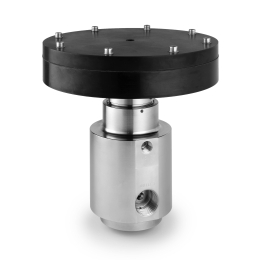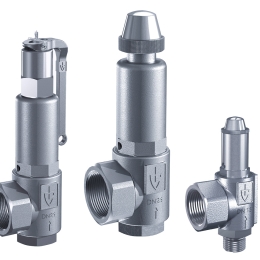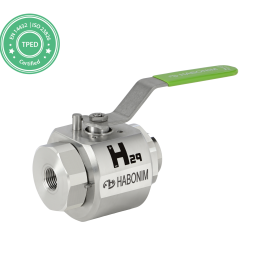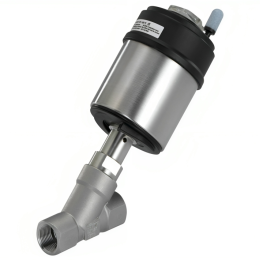Browse hydrogen valves from leading suppliers on our marketplace!
What is a hydrogen valve?
Hydrogen valves are critical safety components used in various hydrogen applications. A hydrogen valve controls the flow of hydrogen (liquid/gas) within the system and thus shuts down the system in case of emergency or leakage. Hydrogen valve design must accommodate the extreme operational conditions, such as high pressure, very low temperatures, and sometimes excessive vibrations, which a hydrogen valve is subjected to. This places an emphasis on the reliability and performance criteria of the valves. At the same time, the valves must also comply with safety requirements during the entire expected lifetime.
Therefore, selecting the correct valve depending on the requirement and application is essential for a safe and stable operation of all kinds of hydrogen systems.
Which type of hydrogen valves exist?
There are different kinds of hydrogen valves available in the market for various applications.
a) Hydrogen needle valve
Hydrogen needle valves are used to regulate the flow of hydrogen in either gas or liquid form through an appliance or system. They are used for accurate flow rate control. The reason it is called a needle valve is because the valve contains a small internal plunger on one end resembling the shape of a needle. This part is within the machinery or the pipeline and cannot be seen. On the other end of the plunger, there is a handle, called the handwheel, for easy and precise rotation of the valve.
In the closed state, the plunger fits exactly into the seat, which is a part of the appliance that is being regulated. However, when the valve is rotated, the gap between the plunger and the seat widens. This allows the substance to pass through the needle valve. You can regulate the needle valve manually or automatically by using a variety of actuators. Controlling the needle valve through an automated device assists in the optimal operation of the valve for the system.
b) Hydrogen ball valve
Hydrogen ball valves are usually shut-off valves that control the fluid flow through the system by means of a rotary ball. The rotary ball is designed with a hole or bore in the center that either allows or blocks the flow of fluid. The ball is mounted against two seats and has a shaft that connects it to the control mechanism that rotates the ball. Thus, the ball valve can be manually or automatically controlled.
In the open state, the control lever arm, which is connected to the ball, is parallel to the pipe and the fluid can flow through the system. When the control lever arm is rotated by a quarter turn (90 degrees), it is moved perpendicular to the pipe and the valve is in the closed state. Ball valves can have multiple ports, which are the openings in the valve. This depends on the application.
c) Hydrogen check valve
Hydrogen check valves are one-way valves that allow the fluid to flow in one direction only and thus prevent reverse flow of fluid in the system. For the check valve to open and allow the flow of fluid, there should be a minimum upstream pressure between the inlet and outlet. This minimum upstream pressure is called the check valve’s ‘cracking pressure’. If the upstream pressure falls below the cracking pressure or there is back pressure, it will result in closing of the check valve.
d) Hydrogen pressure relief valve
A hydrogen relief valve is a safety device which is designed to protect the system when the pressure in the system increases beyond the specified design pressure or maximum allowable working pressure. Thus, when the pressure in the system rises above the set pressure, the valve automatically gets lifted and allows the flow of the medium, thereby releasing the pressure. Once the pressure in the system drops below the reseating pressure, the valve closes. Therefore, a pressure relief valve is important to prevent overpressure events and equipment failure.
e) Hydrogen flow control valve
Hydrogen flow control valves are also used to control the fluid flow in the system. A hydrogen control valve is similar to a needle valve in terms of functionality, which means it can be used for accurate flow rate control. In the closed state, it prevents the flow and as the valve is gradually opened, the flow also increases. But the major difference between a needle valve and flow control valve is that in the case of needle valve the flow is controlled in both directions (bi-directional) while a dedicated flow control valve controls flow only in one direction (allowing free flow in the opposite direction).
f) Hydrogen shut-off valve
A hydrogen shut-off valve is often designed as a hydrogen solenoid valve. This type of valve is used to safely stop or continue the flow of a medium in a system. It consists of two components, valve body and control device. The control element ensures that the valve opens and closes as required. When everything works correctly, the medium passes through the valve in a smooth manner. However, when there is any abnormal condition such as excessive fluid expansion etc., the control device closes the flow passage inside the valve. Therefore, it works similar to an electric switch, which either stops the flow completely or allows it fully. In the use case as hydrogen isolation valves, shut-off valves can be used to isolate sections of a hydrogen fuel circuit.

g) Hydrogen cryogenic valves
Hydrogen Cryogenic valves are mostly employed in areas with very low temperatures where it can withstand and operate effectively at extremely cold temperatures. It is commonly used below -150°C to regulate the flow of fluid. Cryogenic valves are normally kept in a natural closed position to keep cryogenic gasses or other medium secure and safe. As the pressure increases, the cryogenic valve is pushed into an open position to allow the gas or other media to flow readily through. When the pressure again decreases, the valve swings back and is sealed with a special metal seat bubble-tight shutoff to prevent any leaking.
Cryogenic valves are typically made from low coefficients of thermal expansion, such as stainless steel or brass to prevent the valves from becoming brittle and fracture at low temperatures. Design features such as extended bonnets and insulation are added to minimize heat transfer and maintain the temperature of the valve body and other components at low temperatures.
h) Hydrogen globe valves
Hydrogen globe valves regulate the fluid flow in a pipeline using a movable plug/disc-type element and a stationary ring seat. These valves are typically housed in a spherical body, hence the name “globe valve”. It is not a bidirectional valve. The globe valve operates by using a disk, which is an obstruction material, to restrict the flow of liquid in a pipeline.
Rotating the handle wheel clockwise causes the stem and valve plug to move downward, positioning the valve plug securely between the two valve seats, resulting in a complete seal that prevents any fluid leakage. Conversely, turning the handle wheel anticlockwise causes the stem and valve plug to move upward, opening the valve from its closed position and allowing fluid to flow through the globe valve.
i) Hydrogen pressure regulators
Hydrogen Pressure regulators is crucial in controlling and reducing the pressure of hydrogen gas, from a high-pressure source to a lower, more manageable pressure. These regulators consist of an inlet port, a diaphragm or piston mechanism, and an outlet port. As high-pressure hydrogen gas enters the regulator, the internal pressure is monitored. If the pressure exceeds the desired setpoint, the diaphragm or piston mechanism adjusts to restrict the gas flow, maintaining a steady and manageable pressure at the outlet. This enables the regulator to modulate the gas flow and keep the pressure within the desired range, even in the face of fluctuations in the inlet pressure. Thus, hydrogen pressure regulators contribute to the safe and reliable operation of hydrogen-based systems and applications.
j) Hydrogen tank valves
Hydrogen tank valves are essential components for controlling the flow of hydrogen gas in and out of hydrogen storage tanks or cylinders. They consist of various components, including a valve body, stem, seat, and actuator, and can be operated manually or automatically.
During the filling process, the valve allows controlled flow of hydrogen from the supply source into the tank, ensuring that the desired filling pressure is reached. When discharging hydrogen from the tank, the valve facilitates controlled release of the gas, directing it to the intended application or downstream system. They also incorporate features such as pressure relief devices or burst discs to handle overpressure situations. These safety mechanisms help relieve excess pressure, preventing potential hazards and maintaining the integrity of the tank.
Additionally, hydrogen tank valves designed for low-temperature or high-pressure hydrogen storage consider the unique properties and requirements of hydrogen gas in such conditions. They may include temperature pressure release devices (TPRDs) that safely release gas at specific temperature thresholds and excess flow valves to limit maximum outflow in the event of a pipeline rupture.
k) Cathode isolation valves
Cathode Isolation Valves are specialized valves used in the cathode path of a fuel cell system. They are typically installed in the piping or tubing that connects the cathode compartment of an electrolyser to the electrolyte supply or recirculation system. These valves are designed to isolate or control the flow of electrolyte in the cathode compartment of an electrolyser. It ensures an airtight seal of the inlet and outlet of a fuel cell stack when the system is switched off. This maintains consistent conditions within the fuel cell stack, preventing premature aging and enabling a quick system restart. Cathode Isolation Valves include fail-safe features for safe closure of the fuel cell stack when necessary. It also incorporates an electrical actuator for precise regulation of mass flow and fuel cell stack pressure, allowing for efficient and safe operation.
l) Hydrogen pressure solenoid valve
Hydrogen Pressure Solenoid Valves are electromechanically operated devices used to control the flow of hydrogen gas. These valves employ a solenoid coil that generates a magnetic field to move a plunger inside the valve, thereby opening or closing the valve. They are known for their compact design and are commonly used in applications requiring precise fluid flow control. Hydrogen Pressure Solenoid Valves offer several advantages, including fast and safe switching, low energy consumption, high reliability, and compatibility with hydrogen-based applications.
There are two main types of working principles for hydrogen pressure solenoid valves: direct-acting and pilot-operated. In direct-acting solenoid valves, the solenoid coil generates an electromagnetic force that moves a plunger directly to open or close the valve. The plunger’s movement is solely based on the magnetic field. On the other hand, pilot-operated solenoid valves utilize an auxiliary pilot valve along with the magnetic field. When the solenoid is activated, the pilot valve opens, allowing a small amount of fluid to enter the main valve. This change in system pressure then opens the main valve to enable fluid flow. When the solenoid is de-energized, the pilot valve closes, causing the main valve to close and halt the fluid flow.
What are the main use cases for each type of hydrogen valve?
Liquid hydrogen valves are used in hydrogen fueling stations, pressure fluid handling systems, and compression systems. Likewise, we would find a liquid hydrogen valve used for flow control in e.g. hydrogen fuel cell test systems, hydrogen fueling stations, storage and manufacturing systems. This applies specifically to use cases where hydrogen is handled and processed in liquid form, following compression or cryogenic liquefaction.
Hydrogen gas valves as found in electrolysis and hydrogen storage systems, and these are often designed as ball-type valves. A hydrogen gas valve may be used as a shut-off valve in low pressure applications within the realm of hydrogen storage and transportation, or in situations where expansion of hydrogen fuel from liquid to gaseous state must be expected.
High pressure hydrogen valves are used as pressure relief valves, e.g. in hydrogen boilers and plants, on pressure tanks, for process technology, storage and transportation of hydrogen. A hydrogen tank valve would normally be designed as a ball-type shut-off valve. Hydrogen valve use cases are outlined in the following table:
| Type of Valve | Use Cases |
| Hydrogen Needle Valve | Hydrogen fueling stations, Pressure fluid handling system, Compression systems |
| Hydrogen Ball Valve | Electrolysis, Hydrogen storage |
| Hydrogen Check Valve | Hydrogen Refilling stations, Fuel cells, Hydrogen processing, Process system control and shut-off |
| Hydrogen Pressure Relief Valve Valve | Hydrogen boilers and plants, Pressure tanks, Process technology, Storage and transportation of hydrogen |
| Hydrogen Flow Control Valves | Hydrogen fuel cell test systems, Hydrogen fueling, storage and manufacturing systems |
| Hydrogen Shut-off Valves | Hydrogen Storage and transportation |
What are the main performance criteria of each type of valve?
Hydrogen valve specifications known to be key performance criteria according to the type of valve are listed in the following table:
| Type of Valve | Key Performance Criteria |
| Hydrogen Needle Valve | Operating pressure, port and orifice size of valve, fluid temperature and valve material |
| Hydrogen Ball Valve | Sealing material, circuit function, operating pressure, fluid temperature, valve connection type and valve material |
| Hydrogen Check Valve | Maximum fluid pressure, Cracking pressure, valve material, flow characteristics |
| Hydrogen Pressure Relief Valve | Set pressure, Back pressure, blow-off capacity, valve and seal material, fluid temperature |
| Hydrogen Flow Control Valves | Operating pressure, port and orifice size of valve, fluid temperature and valve material |
| Hydrogen Shut-off Valves | Operating pressure, port and orifice size of valve, fluid temperature and valve material |
What are EC-79 directive for hydrogen valves?
Hydrogen valve manufacturers competing in the market must comply with the EC-79 safety-related regulation for hydrogen-powered vehicles and hydrogen systems. This EC 79 directive also applies to components designed for those types of vehicles. Both liquid and compressed gaseous hydrogen are included in this regulation.
EC79 type-approval applies to all types of hydrogen valves, among other components. Read the full text of the REGULATION (EC) No 79/2009 on type-approval of hydrogen-powered motor vehicles
EC-79 requirements
- Hydrogen components should be able to withstand electrical, mechanical, thermal and chemical operating conditions without leaking or visible deformation.
- Hydrogen systems should be protected against over-pressurization.
- The materials used for hydrogen components and systems which will be in direct contact with hydrogen should be compatible with hydrogen.
- Hydrogen components and systems should be able to reliably withstand expected temperatures and pressures during their expected lifetime.
- The flow direction should be clearly indicated for hydrogen components with directional flow.
- Hydrogen components and systems should be designed in such a way that they can be installed and protected against damage.
The tests conducted on hydrogen valves for EC-79 type approval include Pressure test, Seat leakage test, Ozone aging test, Temperature cycle test, Hydrogen compatibility test etc. for liquid hydrogen. For gaseous hydrogen, tests such as material tests, corrosion resistance test, endurance test etc. is conducted.
Last update: 01.02.2023







